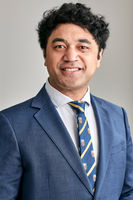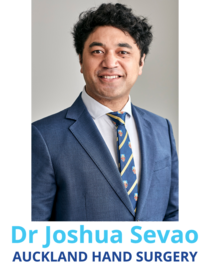Central Auckland, East Auckland, North Auckland, South Auckland, West Auckland > Private Hospitals & Specialists >
Dr Joshua Sevao - Orthopaedic Hand & Wrist Surgeon
Private Service, Orthopaedics
Description
Dr Sevao consults from clinics in Takapuna and Albany on Auckland's North Shore, and in West Auckland from a clinic in Henderson. He operates at North Shore Surgical Centre and Southern Cross Hospital North Harbour.
What is Orthopaedics?
Consultants
-

Mr Joshua Sevao
Orthopaedic Hand & Wrist Surgeon
How do I access this service?
Referral
Contact us
Ph: (09) 320 1325
Email: office@handsurgery.co.nz
Referral Expectations
You need to bring to your appointment with you:
Fees and Charges Categorisation
Fees apply
Fees and Charges Description
Joshua is a Southern Cross Affiliated Provider and NIB First Choice member.
Hours
Our reception team can respond to your enquiries between 9am to 5pm, Monday to Friday
Procedures / Treatments
For elderly patients joint replacement surgery is commonly required to treat damaged joints from wearing out, arthritis or other forms of joint disease including rheumatoid arthritis. In these procedures the damaged joint surface is removed and replaced with artificial surfaces normally made from metal (chromium cobalt alloy, titanium), plastic (high density polyethylene) or ceramic which act as alternate bearing surfaces for the damaged joint. These operations are major procedures which require the patient to be in hospital for several days and followed by a significant period of rehabilitation. The hospital has several ways of approaching the procedure for replacement and the specifics for the procedure will be covered at the time of assessment and booking of surgery. Occasionally blood transfusions are required; if you have some concerns raise this with your surgeon during consultation.
For elderly patients joint replacement surgery is commonly required to treat damaged joints from wearing out, arthritis or other forms of joint disease including rheumatoid arthritis. In these procedures the damaged joint surface is removed and replaced with artificial surfaces normally made from metal (chromium cobalt alloy, titanium), plastic (high density polyethylene) or ceramic which act as alternate bearing surfaces for the damaged joint. These operations are major procedures which require the patient to be in hospital for several days and followed by a significant period of rehabilitation. The hospital has several ways of approaching the procedure for replacement and the specifics for the procedure will be covered at the time of assessment and booking of surgery. Occasionally blood transfusions are required; if you have some concerns raise this with your surgeon during consultation.
The division of a crooked or bent bone to improve alignment of the limb. These procedures normally involve some form of internal fixation, such as rods or plates, or external fixation which involves external wires and pins to hold the bone. The type of procedure for fixation will be explained when the surgery is planned.
The division of a crooked or bent bone to improve alignment of the limb. These procedures normally involve some form of internal fixation, such as rods or plates, or external fixation which involves external wires and pins to hold the bone. The type of procedure for fixation will be explained when the surgery is planned.
A large number of orthopaedic procedures on joints are performed using an arthroscope, where a fibre optic telescope is used to look inside the joint. Through this type of keyhole surgery, fine instruments can be introduced through small incisions (portals) to allow surgery to be performed without the need for large cuts. This allows many procedures to be performed as a day stay and allows quicker return to normal function of the joint. Arthroscopic surgery is less painful than open surgery and decreases the risk of healing problems. Arthroscopy allows access to parts of the joints which can not be accessed by other types of surgery.
A large number of orthopaedic procedures on joints are performed using an arthroscope, where a fibre optic telescope is used to look inside the joint. Through this type of keyhole surgery, fine instruments can be introduced through small incisions (portals) to allow surgery to be performed without the need for large cuts. This allows many procedures to be performed as a day stay and allows quicker return to normal function of the joint. Arthroscopic surgery is less painful than open surgery and decreases the risk of healing problems. Arthroscopy allows access to parts of the joints which can not be accessed by other types of surgery.
In many cases tendons will be lengthened to improve the muscle balance around a joint or tendons will be transferred to give overall better joint function. This occurs in children with neuromuscular conditions but also applies to a number of other conditions. Most of these procedures involve some sort of splintage after the surgery followed by a period of rehabilitation, normally supervised by a physiotherapist.
In many cases tendons will be lengthened to improve the muscle balance around a joint or tendons will be transferred to give overall better joint function. This occurs in children with neuromuscular conditions but also applies to a number of other conditions. Most of these procedures involve some sort of splintage after the surgery followed by a period of rehabilitation, normally supervised by a physiotherapist.
A pinched nerve in the wrist that causes tingling, numbness and pain in your hand may require surgery to make more room for the nerve. This operation is usually performed under local anaesthetic (the area being treated is numb but you are awake). Surgery to relieve carpal tunnel syndrome involves making a cut (incision) from the middle of the palm of your hand to your wrist. Tissue that is pressing on the nerve is then cut to release the pressure.
A pinched nerve in the wrist that causes tingling, numbness and pain in your hand may require surgery to make more room for the nerve. This operation is usually performed under local anaesthetic (the area being treated is numb but you are awake). Surgery to relieve carpal tunnel syndrome involves making a cut (incision) from the middle of the palm of your hand to your wrist. Tissue that is pressing on the nerve is then cut to release the pressure.
A pinched nerve in the wrist that causes tingling, numbness and pain in your hand may require surgery to make more room for the nerve. This operation is usually performed under local anaesthetic (the area being treated is numb but you are awake).
Surgery to relieve carpal tunnel syndrome involves making a cut (incision) from the middle of the palm of your hand to your wrist. Tissue that is pressing on the nerve is then cut to release the pressure.
This condition occurs when there is abnormal thickening of the deep tissue between the palm of your hand and your fingers. This thickening occurs very gradually and will start to make your fingers curl toward your palm. If this condition gets to the stage where it significantly limits your hand function, surgery may be recommended. This usually involves removal of the thickened tissue, allowing you to straighten your fingers again.
This condition occurs when there is abnormal thickening of the deep tissue between the palm of your hand and your fingers. This thickening occurs very gradually and will start to make your fingers curl toward your palm. If this condition gets to the stage where it significantly limits your hand function, surgery may be recommended. This usually involves removal of the thickened tissue, allowing you to straighten your fingers again.
This condition occurs when there is abnormal thickening of the deep tissue between the palm of your hand and your fingers. This thickening occurs very gradually and will start to make your fingers curl toward your palm.
If this condition gets to the stage where it significantly limits your hand function, surgery may be recommended. This usually involves removal of the thickened tissue, allowing you to straighten your fingers again.
Problems with the appearance or function of the hand can be the result of injury, birth defects or degenerative conditions. Transplantation Fingers or hands that have been accidentally cut off can be reattached by very detailed surgery that is performed under a microscope (microsurgery) and involves reconnecting tendons, blood vessels and nerves. Arthritis Arthritis is a condition in which a joint and the surrounding tissue become swollen and painful. If surgery is necessary, it may involve replacement of the joint with an artificial joint or removal or repair of swollen or damaged tissue. Birth Abnormalities Surgery may sometimes be required for hand abnormalities that are present at birth such as too many or too few fingers, webbed fingers or joints that won’t bend. Injuries Damage to tendons, nerves, joints and bones in the hand may require surgical repair. In some cases, tissue may be transferred from a healthy part of your body to the injured site (grafting).
Problems with the appearance or function of the hand can be the result of injury, birth defects or degenerative conditions. Transplantation Fingers or hands that have been accidentally cut off can be reattached by very detailed surgery that is performed under a microscope (microsurgery) and involves reconnecting tendons, blood vessels and nerves. Arthritis Arthritis is a condition in which a joint and the surrounding tissue become swollen and painful. If surgery is necessary, it may involve replacement of the joint with an artificial joint or removal or repair of swollen or damaged tissue. Birth Abnormalities Surgery may sometimes be required for hand abnormalities that are present at birth such as too many or too few fingers, webbed fingers or joints that won’t bend. Injuries Damage to tendons, nerves, joints and bones in the hand may require surgical repair. In some cases, tissue may be transferred from a healthy part of your body to the injured site (grafting).
Problems with the appearance or function of the hand can be the result of injury, birth defects or degenerative conditions.
Transplantation
Fingers or hands that have been accidentally cut off can be reattached by very detailed surgery that is performed under a microscope (microsurgery) and involves reconnecting tendons, blood vessels and nerves.
Arthritis
Arthritis is a condition in which a joint and the surrounding tissue become swollen and painful. If surgery is necessary, it may involve replacement of the joint with an artificial joint or removal or repair of swollen or damaged tissue.
Birth Abnormalities
Surgery may sometimes be required for hand abnormalities that are present at birth such as too many or too few fingers, webbed fingers or joints that won’t bend.
Injuries
Damage to tendons, nerves, joints and bones in the hand may require surgical repair. In some cases, tissue may be transferred from a healthy part of your body to the injured site (grafting).
Additional Details
Face to face / Kanohi ki te Kanohi, Phone, Online / virtual / app, Child / Tamariki friendly, LGBTQIA+ friendly
Public Transport
The Auckland Transport website is a good resource to plan your public transport options.
Parking
Free patient parking is available at all locations
Pharmacy
Find your nearest pharmacy here
Website
Contact Details
Northcare, 5 Home Place, Rosedale, Auckland
North Auckland
-
Phone
(09) 320 1325
Healthlink EDI
jshsevao
Email
Website
131 Lincoln Road, Henderson, Auckland
West Auckland
-
Phone
(09) 320 1325
Healthlink EDI
jshsevao
Email
Website
177 Montgomerie Road, Māngere, Auckland
South Auckland
-
Phone
(09) 320 1325
Healthlink EDI
jshsevao
Email
Website
Was this page helpful?
This page was last updated at 12:22PM on February 16, 2024. This information is reviewed and edited by Dr Joshua Sevao - Orthopaedic Hand & Wrist Surgeon.

